Though blooming flowers are greatly associated with the seasons of spring and summer, a lot of flowers bloom in the fall. Sometimes they simply have a long blooming season that stretches into autumn, and other times they first blossom in fall. For many of these flowers, Idaho provides a perfect environment for growth. The state has hardiness zones that range from 3 in the north to 7 in the south, a wonderfully varied climate, and an abundance of rich, loamy soil. Here are 11 of the most colorful fall-blooming flowers that appear in Idaho.
1. Goldenrod
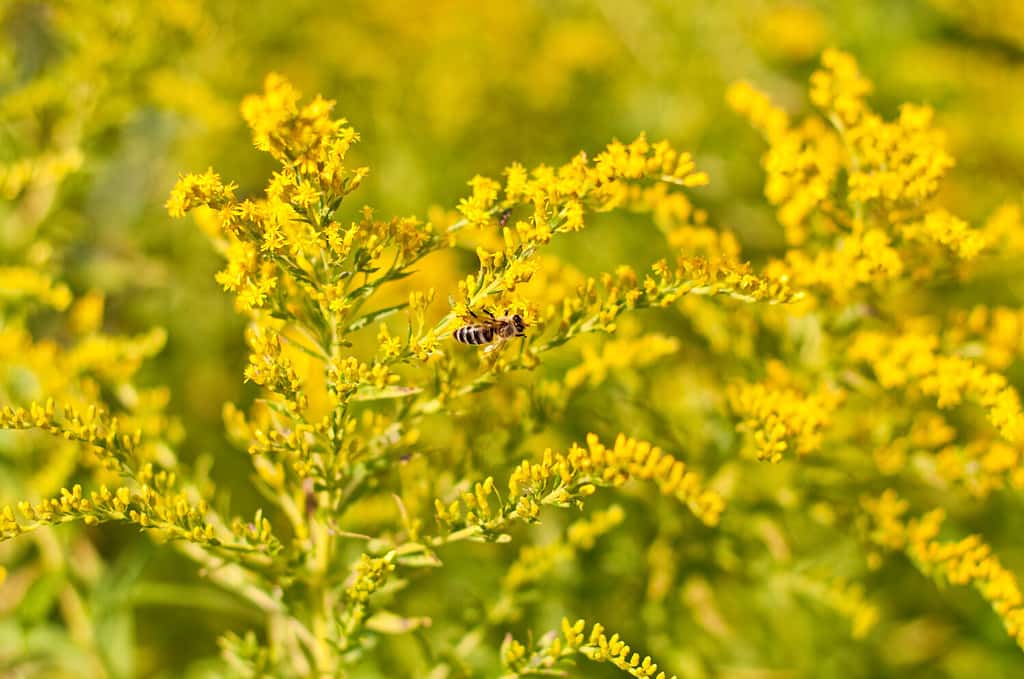
Goldenrod is irresistible to pollinators like this honeybee.
©Greg Kushmerek/Shutterstock.com
A harbinger of fall, goldenrods of the Solidago genus produce tiny golden or yellow flowers in clusters at the very ends of stems that can grow from 1 to 6 feet or taller. The leaves are narrow and toothed. Goldenrod is often mistaken for ragweed, though they don’t look anything alike. Moreover, goldenrod isn’t responsible for fall allergies. The pollen is too heavy to be carried on the wind and needs to be transported by insects such as bees and wasps. These pollinators flock to the flowers in great numbers.
Goldenrod grows in well-drained, loamy soil and thrives in all of Idaho’s hardiness zones. It also does well in full sun to light shade. The flowers, fresh or dried, are excellent for fall floral arrangements.
2. Aster
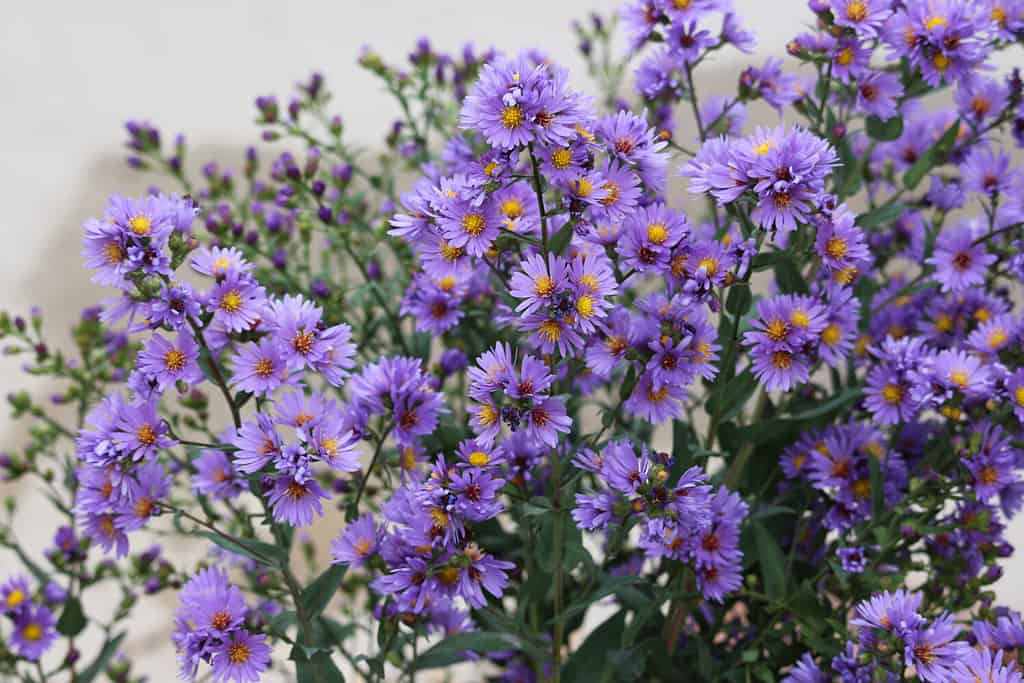
Asters look like daisies, but come in many colors.
©Jerrold James Griffith/Shutterstock.com
Asters also flourish in Idaho’s time zones, climate and soil. The flowers are daisy-like and come in shades of white, blue, pink, or purple. Asters can grow from 6 inches and make wonderful ground covers, or they can grow to 8 feet tall and need a bit of staking to not flop over. The plant sometimes has trouble with mildew and needs to be placed in an area with full sun and good air circulation. Well-drained soil prevents root rot. Asters are perennials, and during the winter those planted in zones colder than Zone 5 should be mulched over. Divide the flowers every two years or so if the centers look like they’re dying out.
3. Coneflower

These fall-blooming flowers have yellow petals and prominent central cones.
©Lubo Ivanko/Shutterstock.com
Coneflowers grow well in hardiness Zone 4 and warmer. Like asters, they are daisy-like, but their petals are orange or yellow and surround a protruding center. The centers are made even more noticeable because the petals bend out and downward. The leaves are deeply cut and form clumps beneath the flowers. Coneflower plants grow from 18 inches to over 6 feet tall and need average loamy soil, and full sun to light shade.
4. Stonecrop
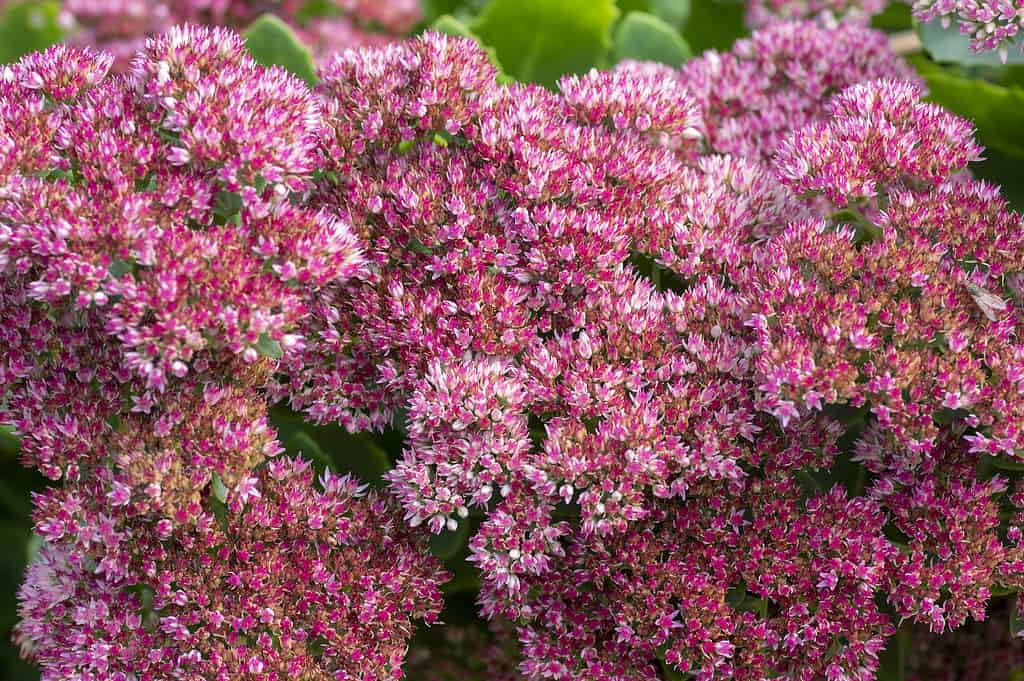
The fall-blooming stonecrop extends the beauty of your garden.
©Iva Vagnerova/ via Getty Images
Good for all of Idaho’s hardiness zones, stonecrop is famously used as a perennial ground cover as it grows from 3 inches to 2 feet tall. Because it blossoms in the fall, stonecrop extends the beauty of any garden. Indeed, some stonecrop varietals will keep on blossoming into winter. The leaves are thick and succulent and come in colors of green, blue-green, or red. The flowers are white, yellow, pink, orange, or red. They’re small, with five petals that give them a starry look. They blossom in clusters that may hide the leaves and are irresistible to butterflies.
Though stonecrop does best in well-drained loamy soil and in full sun to light shade, it bears up well under drought conditions and in poor soil. This makes it just right for a rock garden. Though stonecrop spreads, it doesn’t become invasive, and you won’t need to divide it for years.
5. Chrysanthemum
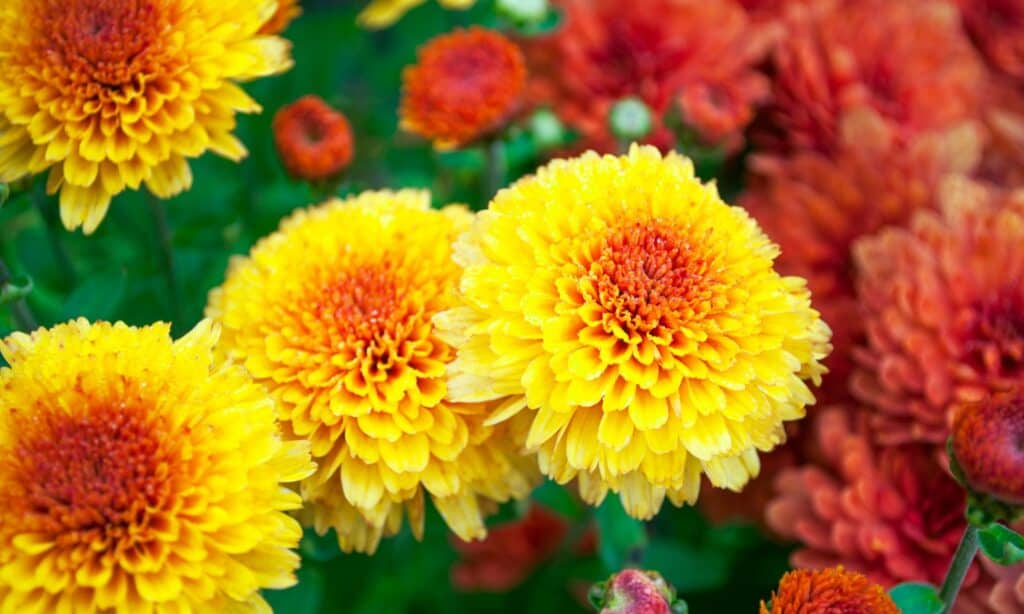
Chrysanthemums come in every color but blue.
©Elan Havrilyuk/Shutterstock.com
Good for hardiness Zone 4 and up, chrysanthemums appear in every color but blue. There are thousands of varieties, so flowers come in a wealth of sizes, from football mums to button mums. Yet, the chrysanthemum blossom is basically a central disk of flowers surrounded by ray flowers. The leaves usually come in leaflets, or they’re lobed or toothed. The plants grow from 1 to 3 feet in height, and there are even bonsai chrysanthemums with tiny flowers.
Chrysanthemums do best in fertile loam and full sun to part shade. Well cared for chrysanthemums come back year after year, but their roots are shallow and need lots of watering and fertilizing. Mulch the roots in the winter in the colder zones to keep them from heaving out of the soil after a hard frost.
6. Dahlia
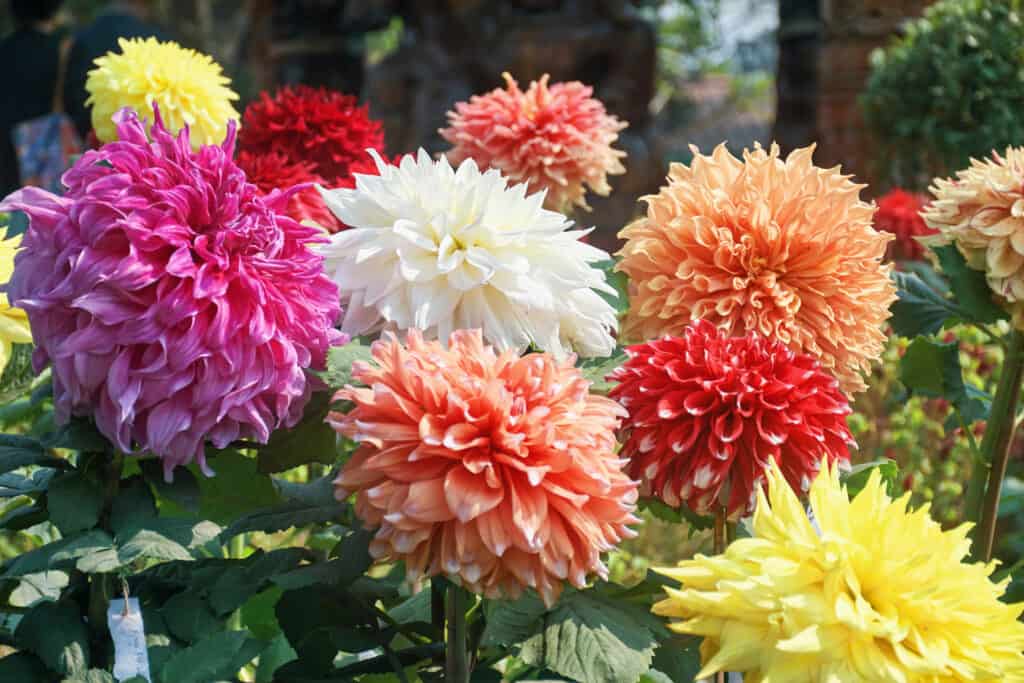
Dahlias can grow to 8 feet tall.
©suprabhat/Shutterstock.com
Besides being fall-blooming flowers, dahlias are notable for being more genetically diverse than most other plants. This allows their flowers to enjoy a great variety. Flowerheads, which always come one to a stem, can be tiny or large as dinner plates. The plants can also be low growing or reach 8 feet in height. Like their cousins the chrysanthemums, dahlias come in just about every color but blue. There may be pictures of artificially colored blue dahlias, but the plant simply can’t make this pigment.
Dahlias are actually perennial flowers, but they are grown as annuals in places like Idaho, whose winters are cold. They’re hardy from zones 7 to 10, so they can do well in the southern part of the state. If you wish, you can take the tubers out of the ground and store them over the winter in damp, but not wet, peat moss. Replant the tubers one or two weeks before the date of the last frost.
Like chrysanthemums, dahlias have a central flower head circled by rays. These rays look like petals, but they are actually flowers in their own right. The plants need full sun, medium watering and well-drained soil. Taller plants may need to be staked, and you should feed the plants with nitrogen during the growing season. Dahlias are native to Central America and Mexico, and people used to eat their tubers.
7. Anemone
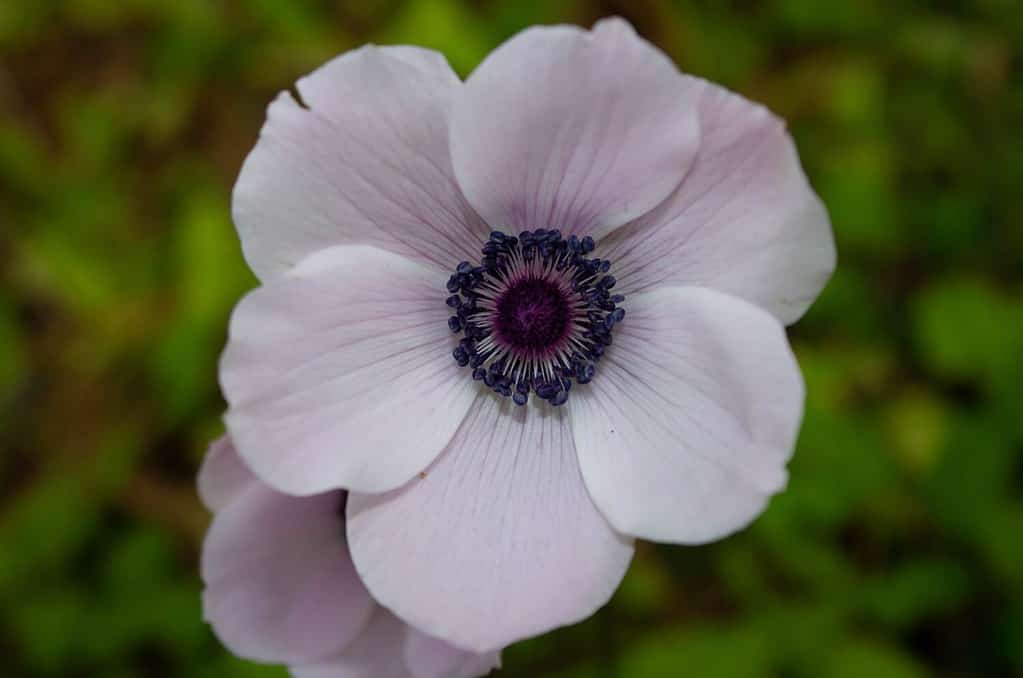
Anemones have tepals instead of petals.
©yurumesafesi/Shutterstock.com
Also called the windflower, this plant thrives in zones 2 through 8 and is just the thing for the Idaho fall garden. The flowers come in white, purple, cream, blue, or red, and they’re from 1 to 3 inches around with single or double petals. They grow 2.5 to 3 feet tall on wiry stems above mounds of beautiful, dark green, toothed leaves on long leaf stalks. The flowers don’t have petals but tepals surrounding a button of yellow stamens. Japanese anemones in particular are known to bloom until the first frost.
Anemones thrive in well-drained loamy soil that’s a bit alkaline. The soil must always be somewhat moist and not allowed to dry out. Though it likes partial shade to full sun, the anemone is at its best in partial shade. If there’s too much shade, the flowers flop over. If it gets too hot and sunny, the foliage burns. It takes time for anemones to establish, but once they do, they’ll form beautiful colonies through their root system.
8. Marigold
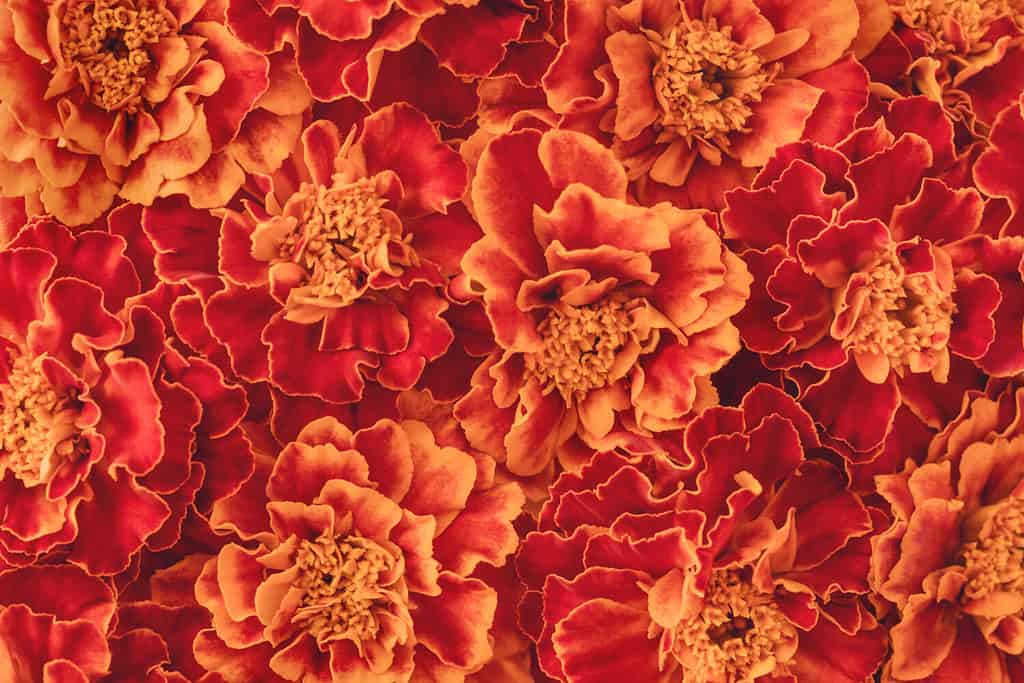
Gardeners love these fall-blooming flowers because they attract pollinators and repel pests.
©ganjalex/Shutterstock.com
Another tough and adaptable fall-blooming plant, the marigold, specifically the African marigold, is perfectly at home in hardiness zones 2 to 11. It reliably blooms until frost, but unfortunately, it’s an annual, so you’ll need to replace it for next season. The beautiful, ruffly flowers of this plant come in shades of orange, yellow and white. Not only the blossoms but the very leaves of the plant are fragrant, and they attract hummingbirds and butterflies. Gardeners also plant marigolds next to their fall vegetable crops to dissuade pests. The marigold can tolerate deer and heavy, clayey soils.
The African marigold grows between 1 and 4 feet tall and sports big, round flowers. The leaves are pinnate, and the leaflets are lance-shaped and toothed. Despite its name, the African marigold is native to Mexico. Some botanists believe it’s basically the same flower as the French marigold, whose blossoms are smaller. By the way, like the African marigold, the French marigold is native to Mexico.
Marigolds perform best in full sun and well-drained soil that’s kept evenly moist. They are famously bought in packs from nurseries or grown easily from seed.
9. Autumn Crocus
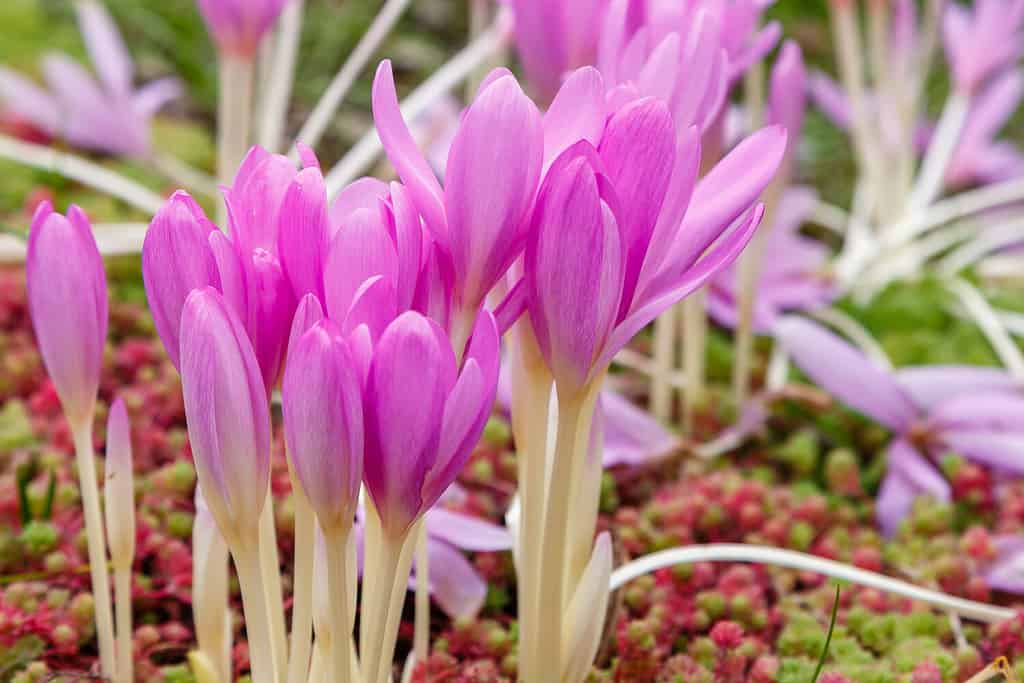
People associate crocuses with spring, but some types of crocuses are fall-blooming flowers.
©Greens and Blues/Shutterstock.com
The crocus may be a sign of spring, but there’s another crocus that’s a sign of fall. This one is Colchicum autumnale, or the autumn crocus. Hardy from Zone 4 to Zone 8, this plant can also be used as a ground cover as it grows from .50 to .75 of a foot tall with a similar spread. The flower is a delicate lavender pink, but before it arrives the plant sends up 10 inch long, lance-shaped green leaves in the spring. The leaves die back by summer, and the plant goes dormant. Then, flower stems pop out of the ground in late summer or early fall. Each one holds a beautiful, star-shaped flower. Because the flowers have no leaves, the autumn crocus’ other name is naked ladies. By the way, this flower and the spring flower aren’t very closely related.
Autumn crocuses grow from corms. It does best in full sun to partial shade in rich soil that’s kept moist but well-drained. The best time to plant for fall flowering is in August, and the plants should be divided every three years or so. Autumn crocus is an excellent flower for woodland and meadow gardens.
10. Zinnias
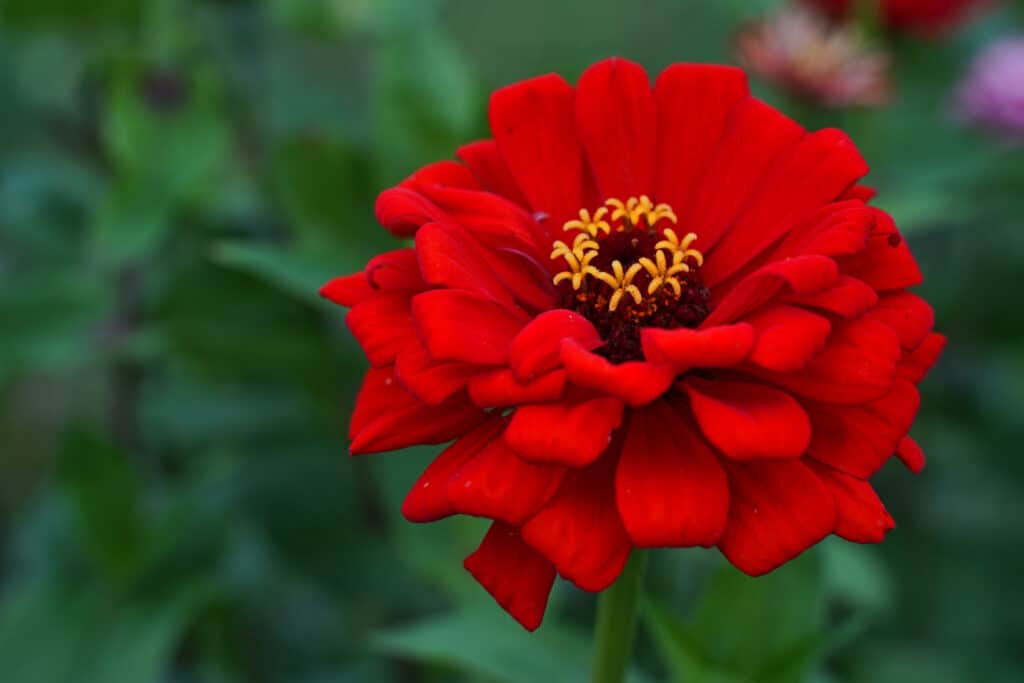
Zinnias are wonderful flowers for edges and containers.
©iStock.com/Kathy Reasor
Like marigolds, Zinnia angustifolia plants are annuals but are eye-catching in the garden. Zinnia flowers are borne, one at a time, on long stems, and each flower has 12 petals. They come in glorious shades of white, red, orange, pink, and yellow. Like the marigold, zinnias thrive from zones 2 to 11 and won’t stop blooming till frost. To encourage blossoms, make sure to deadhead the plant after the flower is spent.
The zinnia plant grows to between .75 of a foot to 1.5 feet tall, with a .75 to 1 foot spread, so can be used as a ground cover. It likes full sun, and though soil that’s kept evenly moist is ideal, it does well in soil that’s somewhat dry. Zinnias are good for edges and bedding and are just right for container gardening.
11. Garden Pansy

Pansies like growing conditions to be on the cool side.
©Nitr/Shutterstock.com
Garden pansies thrive in hardiness zones 3 to 9 in well-drained loam that’s kept moist. They can even endure light freezes and a dusting of snow. They get their name from the French pensée, which means “thought.” These flowers symbolize remembrance.
The pansy grows about 9 inches high, and its flower is about 2 to 3 inches in diameter. It has five petals that often incorporate two or three vibrant colors such as purple, yellow, white, rose, red, orange, or blue. Some pansies are such a dark shade of purple that they may as well be velvety black. The two upper petals overlap, there are two petals on the side and the lowest petal has a little beard. The middle of the flower often bears a blotch or an eye, and to some people it resembles a face. Whether the face is cheerful or crabbed depends on the folklore.
Pansies prefer six hours of sun, and the climate and soil of Idaho are ideal for this fall-blooming flower. It flourishes when night temperatures are in the 40s (degrees Fahrenheit) and the days are in the 60s. They don’t like intense heat and tend to flop over when it arrives. Pansies also appreciate a slow-release fertilizer when they’re in the ground, and liquid fertilizer if they’re in containers.
The photo featured at the top of this post is © iStock.com/aga7ta
Thank you for reading! Have some feedback for us? Contact the AZ Animals editorial team.







